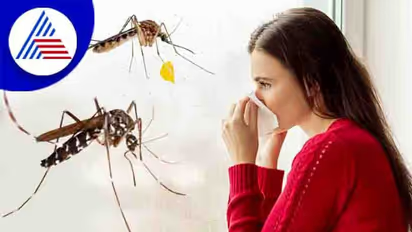Monsoon in India: Common Indian rainy season diseases; Why do infections spread faster in THIS weather?

Synopsis
Monsoon infections are frequently undiagnosed, causing organ damage. However, careful cleaning, prevention, and early diagnosis can keep you safe throughout this horrible illness season.
Did you know that monsoon doubles the danger of various viruses, germs, and other infections? Because air moisture increases, dangerous microbes thrive and disease transmission increases. Monsoon illnesses are generally undiagnosed until they damage organs. However, proper cleanliness, prevention, and early diagnosis can keep one safe throughout this terrible season of infections.
Common Indian Monsoon Diseases
A. Mosquito diseases
Mosquitoes breed during monsoon. Mosquito-borne infections have increased significantly. India has 34% of global dengue cases and 11% of global malaria cases.
• Plasmodium, a single-celled parasite spread by female Anopheles mosquitoes, causes malaria, a significant health problem in India during the monsoon season. During monsoon season, water channels and streams are abundant with Anopheles, which increases parasite transmission and malaria incidence.
• Dengue is a viral fever caused by dengue fever. It is spread by the Aedes aegypti mosquito, which breeds in stagnant water like wells, flower pots, tree holes, and buckets or drums. Adapting to landscape changes and urbanisation, these creatures now live in urban dwellings.
• Chikungunya, a non-fatal viral disease, is spread by the Aedes albopictus mosquito, which breeds in stagnant water and bites throughout the day. ‘Chikungunya’ means ‘that which bends you up or causes stooped walking’. The condition is named after its arthritic symptoms, including joint and bone stiffness and discomfort.
Tips for Mosquito-borne Disease Prevention During this monsoon, employ mosquito netting in your home.
• Ensure no water collecting or stagnant puddles around the home.
• Ensure cleanliness in baths and washrooms.
• Apply mosquito repellents before leaving home.
B. Waterborne Diseases
According to WHO figures, water-borne infections affect nearly 3.4 million Indians annually. Children are most susceptible to illnesses due to their growing immune systems.
• Typhoid, caused by the S. Typhi bacterium. This water-borne illness spreads due to poor sanitation and hygiene. It is spread by feces-contaminated food or water after touching contaminated things and without washing. Drinking polluted water and consuming spoiled food are the main causes of typhoid.
• Cholera, caused by inadequate sanitation and contaminated food, causes diarrhoea or loose movements.
• Leptospirosis (Weil's Syndrome). Monsoon-season contact with polluted water or mud is the main source of leptospirosis. Shivers, muscular discomfort, headache, and fever occur. Cover injuries and bruises before heading outside.
• Jaundice, a water-borne illness, causes yellowing of the sclera, urine, and mucous membranes, as well as vomiting, liver failure, exhaustion, and weakness. Poor sanitation and tainted food and water spread it. EXAMPLE: Hep A/E
• Gastrointestinal infections, such as vomiting and diarrhoea, result from consuming old, uncovered, or polluted food and drink.
How to Avoid Water-Borne Diseases This Monsoon
Water-borne infections can be avoided by taking precautions:
• Drinking boiling and chilled water.
Prior to ingestion, properly wash fruits and vegetables.
• Ensure food is always covered.
• Avoiding outside food consumption.
• Maintain personal and environmental hygiene 24/7 (use hand sanitizer or wash hands often).
• Reduce water stagnation by sealing open drains and potholes around your property.
Ensure your youngsters receive all seasonal immunisations.
C. Airborne Diseases
As monsoon arrives, airborne diseases flare. Small viruses spread flu, viral fever, colds, coughs, and sore throats through the air. Most infections are minor and self-limiting with rest. However, seniors, pregnant women, immunocompromised patients, and youngsters with growing immune systems are especially susceptible to illnesses during this season.
Common air-borne infections include cold and flu, induced by rapid temperature variations during the monsoon. Weak immune systems make these mild illnesses more likely. Monsoon flu commonly causes sore throat, runny nose, watery eyes, fever, and chills.
• Influenza, A/H1N1
How to Avoid Airborne Diseases This Monsoon?
Personal transmission is easiest for airborne infections. The following precautions will help you enjoy a flu-free monsoon:
• Sneeze into your elbow or cover your mouth and nose with a handkerchief while coughing or sneezing.
Avoid drinking water outside and bring a bottle of boiling water to sip warm water throughout the day.
• Teach youngsters to stay away from persons with flu symptoms or infected individuals.
• Encourage frequent hand-washing and ensuring youngsters completely wash their hands and feet after returning from outdoors.
Keep your homes well-ventilated at all times.
General guidelines: • Stay hydrated by drinking only boiling water and avoiding outside drinks.
• Maintain a thorough personal hygiene practice to prevent fungal infections.
• Wear light, full-sleeved garments for skin protection.
• Eat a nutritious diet to increase immunity.
• Eat fresh, cooked vegetables, limit fats, oils, and salt, and avoid dairy products for dangerous germs.
-Dr. Sunil Havannavar, Senior Consultant - Internal Medicine, Manipal Hospital Sarjapur